Stone Age Science: Rejuvenating the Earth with Rock Dust
Dylan Keating explores the global implications of rock dust and explains why applying it in our gardens can transform our crops.
Let rocks their silence break.
William A. Albrecht
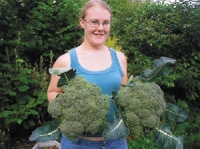
Imagine you go to your local shop and buy an apple. You place it on the counter and pay for it. The shopkeeper cuts it into five pieces, takes four and gives the last one to you. Sounds crazy right? Actually it’s closer to the truth than you might think. A recent report1, based on U.S. agriculture records has found that the nutrient content of fruits and vegetables has been dropping since records were first taken in the early 1960s. So I’d need to be eating five apples today just to get the same nutrients my father did in 1965.
The problem is that soils the world over are chronically deficient in nutrients. Modern fertilizers coupled with intensive cultivation have turned soil into desert, producing cosmetic vegetables lacking the minerals they need for healthy growth. A plant can absorb 70+ minerals from the soil, however it can only absorb the nutrients which are available. If there is only a trace amount of say, calcium in the soil, then the plant cannot absorb the correct amount.
Healthy Soil = Healthy Plants
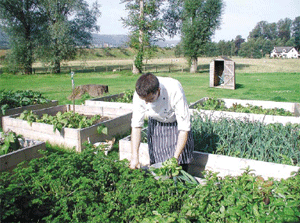
Neil McGown, proprietor and head chef of East Haugh
Hotel Pitlochry, harvesting organic rock dust fed
crops for his guests.
‘The Living Soil’ forms the vital base from which we as humans get our sustenance and without which we would surely perish. But what is soil exactly? Soil is defined as: “The breakdown of rock by physical and chemical weathering over thousands of years.” It’s apparent that almost half of regular soil is weathered rock, with air and water forming another 40-50% and organic matter making up the remaining 50%.
During an ice age, glaciers grind rock down to a fine powder, over thousands of years this leaves a layer up to 2.5m (8ft) deep on the land. This powder combined with organic matter results in ideal nutritional conditions for plants. Tree stumps measured from this period are eight times larger than the largest trees found today.
History
While there are reports2 of the famous healthy Hunza tribe near Pakistan using ground up basalt on their terraces, it was the work of Julius Hensel, who first brought rock dust into the public eye. Hensel was a chemist and free-thinker in Germany who wrote a book called Bread From Stones in the 1850s. His book put forward the theory that ground up rocks would fertilize the fields, doing away with chemical fertilizers. His work was backed up by numerous case studies and many happy farmers.
Unfortunately his vision of an almost free fertilizer was not in line with the vision of newly emerging chemical corporations. At the time the favored theories were the ones of Justus Von Liebig with his flawed NPK theory (which he later recanted). This theory obviously meant bigger profits for the chemical companies. Factories which had produced bombs could now make ‘modern’ fertilizer from their waste products. Hensel was subjected to a campaign to discredit him and ensure that his idea did not get out to the general public. His idea soon disappeared and his book with it.
Essential Elements
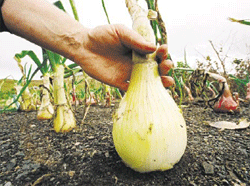
The quality and size of these onions
speaks for itself.
As a soil ages, essential trace elements are lost through weathering, intensive farming and plant growth. It only takes 10 years of intensive agriculture to completely strip the soil of all its minerals. Loss of nutrients leads to loss of immunity. For example, the rate of cancer has been linked to deficiencies in diet: “The area of China with the lowest micro-nutrient intake has the highest rate of cancer. Supplementation with vitamin E, selenium and beta-carotene lowers the rate.”3
As more is learned about trace elements it becomes clear how essential they are for the healthy functioning of a body. For example, trace elements are vital for many processes in the brain. Without them the brain cannot function as it should, the ‘spark’ to fire neutral processes is absent. Enzymes cannot be synthesized without trace elements. Of the 3,000 enzymes that have been identified, over 400 require magnesium to function. If essential micro-nutrients are absent from the soil then your body is not functioning at its optimum.
While we are told to take our vitamins, it is less well known that vitamins regulate the assimilation of minerals in the body. Without minerals they have no function to perform. Studies have shown how mineral deficient children brought up on junk food show a considerable decrease in anti-social behavior if fed a well balanced diet. This link between minerals and health can also be seen in the plant world: Scientist Lee Klinger has had amazing success using rock dust to halt and reverse the signs of ‘sudden oak death’ in California.5 Could this also be used as a prevention for Dutch Elm disease?
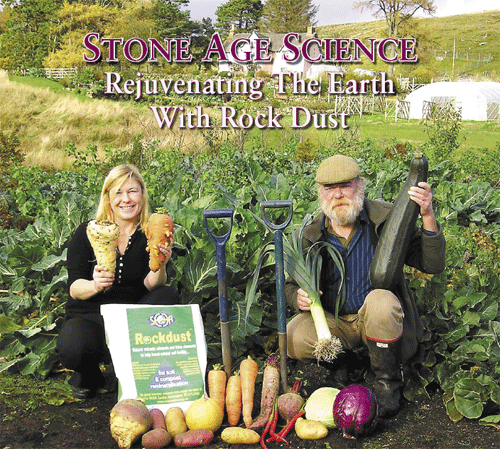
Climate Change
While we continually hear through the media how global warming is affecting the planet, less is being said about global cooling. Newspaper concentrate on parts of the globe which are warming up without paying attention to other regions which are experiencing record cold temperatures. For example, in February 2005 Kashmir received its heaviest snowfall in decades. At the same time it was being reported that icecaps in the Himalayas were melting at an alarming rate.
Supporters of rock dust believe that the use of rock dust can help stablise climate change. The theory goes thus: when glaciers move across the earth they leave a huge deposit of minerals (rock dust) providing for nutrients on which plant life can thrive for the next interglacial period (approximately 10,000) years. Volcanoes perform this role in areas where glaciation does not reach.
As we reach the end of the interglacial period the minerals have mainly left the soil, in our case at an increase rate due to our industrial agriculture and land management. As these minerals leave the soil, plant life decreases and carbon is released. The increased carbon acts as a signal to the planet that minerals are needed. The Earth then goes through a glacier period to replace those nutrients.
Initial studies6 indicate the spreading rock dust can help bind up atmospheric carbon in the soil. If this can be validated further it could be a practical action people can undertake to stabilise climate change. Although spreading rock dust on soil could play a part in climate stabilization, I believe it is one part in a whole series of solutions which needs to be adopted.
The Future of Food?
There are numerous studies which show how crops grown in rock dust are healthier, hardier and produce more than ones without. A recent thesis on the use of granite dust in Denmark found that: ‘rock dust (65.5% granite) increased plant growth in both soil types, compared to control, and this effect is significant at 6.7%. “The thesis concludes that rock dusts are indeed useful as fertilizer and that it has potential in Danish agriculture.”7 Another report this year8 in Malaysia has shown that crops grown with rock dust and EM (effective micro-organisms) show a 400% increase in yield.
In March 2005, I had the opportunity to work at the SEER Centre in Scotland. Founders Cammy and Moira Thomson have dedicated their lives to spreading the word about the wonders of rock dust. And wonders they are: the crops I saw were amazing, healthy and vigorous with a ‘full’ taste that you cannot find on a supermarket shelf.
Rock Dust Around the World
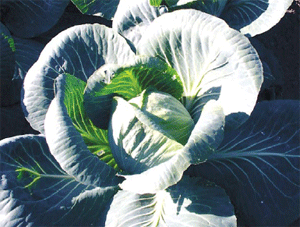
One of Rab Leiper’s large and healthy cabbages.
I learned in December that Grimmway farms, the largest organic farm in the United States have remineralised their whole acreage due to the positive results from crop trials.
While writing this article a book by Graham Harvey entitled We Want Real Food9 was published. The second chapter is all about SEER and the importance of remineralisation. Hopefully with information such as this, people will begin to make more informed decisions about what kind of food they consume. Just as animals eat certain clays to replace lost trace elements, our taste buds let us known the difference between cardboard carrots and real food, grown with care and bursting with flavor.
Instead of just spreading the rock dust on your crops, a very practical solution to remineralise the earth is being pioneered by Australian woman Joy Kogias10. She has developed a different kind of toilet roll impregnated with rock dust and native seeds. Enviro-Roll Sea Tissue is for use on all ocean going vessels, offshore oil platforms, etc. When used and disposed of in fresh or saltwater environments, the toilet paper, which is impregnated with glacial moraine, nourishes the burgeoning phytoplankton which are another element in stabilizing the climate. Enviro-Roll Land Tissue promotes the growth of land vegetation once used and discarded. So every time you go you can do your bit!
A recent conference in Norway11 explored the uses of rock dust in agriculture and the advances in the new field of ‘Agrogeology.’ With an agrogeology centre opening in Indonesia and international conferences taking place it seems that the use of rock dust to restore soil is finally getting the recognition it deserves12.
More developments are happening with a National Task Force for Soil Remineralization being formed in America. This aims to bring farmers and the aggregate industry together to begin large scale remineralisation in the United States.
As we learn more about the link between nutrition and health it becomes obvious that if the basic building blocks for life are not present in our food, then like deficient plants human will increasingly grow in an unpredictable and distorted manner leading to more epidemics, violent behavior and reality TV shows. How we grow our food and the soil that we use is a fundamental key to health, both for humans and the planet.
Further Information:
Further information on climate change and remineralisation can be found at:
www.seercentre.org.uk
www.remineralize.org
Dylan Keating is an organic gardener based in Cornwall.
www.onemillionwords.net
References:
1 www.soilandhealth.org/06clipfile/0601.LEMag/LE Magazine, March 2001 20- Report Vegetables Without Vitamins.htm
2 The Living Soil; Lady Eve Balfour, 1976.
3 Vitamin/mineral supplementation and cancer risk, international chemo-prevention trials; Blot WJ; Proc Soc Ex Biol Med 216:291-6, 1997.
4 Colloidal Minerals and Trace Elements; Marie-France Muller; 2005.
5 www.suddenoaklife.org
6 Donald J. Supkow, 1995.
7 S. Lindegard and I. Nickolajsen; 2005.
8
9 We Want Real Food; Graham Harvey; price L9.99; available from The Green Shopping Catalogue, www.green-shopping.co.uk
10 www.enviro-roll.com
11 www.remineralize.org/news.html
12 www.uoguelph.ca/rocks
Reprinted with permission from Dylan Keating and Permaculture Magazine, www.permaculture.co.uk.
Courtesy of SEER Centre and Angus Horticulture
Support us on Patreon
Thank you for joining us today! Please become a member of RTE and support us on Patreon. Unlike many larger organizations, we work with a team of determined and passionate volunteers to get our message out. We aim to continue to increase the awareness of remineralization to initiate projects across the globe that remineralize soils, grow nutrient dense food, regenerate our forests’ and stabilize the climate – with your help! If you can, please support us on a monthly basis from just $2, rest assured that you are making a big impact every single month in support of our mission. Thank you!







invitations Australia
October 2, 2014 (3:18 am)
Hi! This is my first visit to your blog! We are a group of
volunteers and starting a new project in a community in the
same niche. Your blog provided us beneficial information to work on. You have done a marvellous job!